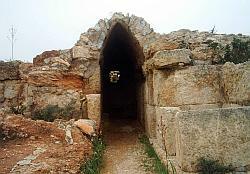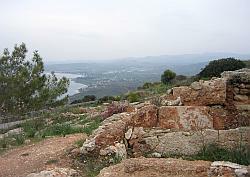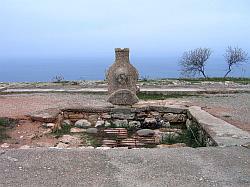 Another major site to see in North Cyprus is the ruin of Vouni which is closely linked to the nearby ruins of Soli on the west coast of the island. Yes, there are many ruins in North Cyprus – which is why, for those of us who love history in any shape or form, it’s a great place to visit!
Another major site to see in North Cyprus is the ruin of Vouni which is closely linked to the nearby ruins of Soli on the west coast of the island. Yes, there are many ruins in North Cyprus – which is why, for those of us who love history in any shape or form, it’s a great place to visit!
You may be best advised to visit the two sites on the same day, as Vouni’s sole reason for being built in the first place was to spy on the daily goings on in the city of Soli. Its location is actually one of its main features, sitting atop a lone plateau with a sheer 250 metre drop to the sea with nothing else around it, leaving you wondering about the amount of time and effort it must have taken to build it in such a remote but commanding place!
 You can reach the site via the coastal road, it’s some four miles past Soli and you turn right on the crest of a hill and follow a narrow road up to Vouni. As with the other major sites to see in North Cyprus, there is a ticket office (7ytl at the time of writing) where you will be given a leaflet detailing the site’s history and the main features to look for.
You can reach the site via the coastal road, it’s some four miles past Soli and you turn right on the crest of a hill and follow a narrow road up to Vouni. As with the other major sites to see in North Cyprus, there is a ticket office (7ytl at the time of writing) where you will be given a leaflet detailing the site’s history and the main features to look for.
Its history seems to date from the 5th century BC, and is said to have been built by a Persian sympathiser king of the nearby city of Marion. Wishing to remain loyal to the Persians, he built the palace of Vouni to literally spy on Soli. Its position certainly meant that sea traffic and the comings and goings to and from the city could be monitored without hindrance.
There was also the possibility that the ancient site of Aepia could have previously been located here too, as the word Vouni in Modern Greek means mountaintop, as does Aepia in Ancient Greek. However, this assumption seems  unfounded as subsequent excavations have not been able to prove this, and therefore archaeologists are confident that, given its characteristics and eastern influences, it was definitely built by Persians, or at least during Persian rule.
unfounded as subsequent excavations have not been able to prove this, and therefore archaeologists are confident that, given its characteristics and eastern influences, it was definitely built by Persians, or at least during Persian rule.
Vouni then came under Greek rule after General Kimon defeated the city of Marion in around 449BC, and Vouni went through a separate phase of construction and design changes. It wasn’t long however until the greedy King of Salamis, Evagoras, declared his desire to rule the whole island and Soli was forced to join together with the enemy to defeat him. In return the Persians reinstated Soli’s power and subsequently destroyed Vouni in 380BC altogether, therefore preventing any further threat. Since this time Vouni has never been used.
Even though Vouni is referred to as a palace, it was never really used as such, being more of a functional operation housing business rooms, halls, kitchens, store rooms, living quarters and the like. The layout is not as fascinating as Soli maybe, but one of its major  attractions lies beneath the foundations, with a hugely sophisticated plumbing system which pre-dates that of Salamis near Famagusta by some 500 years. Storage for rain water was made by digging out rocks to form containers. In the courtyard a stone stele (a cylindrical stone slab used as an axis) still remains which would have been used to lift water from the cistern. Channels were also made to link rooms to a constant supply of water, and there is also a bathhouse which has evidence of a furnace below.
attractions lies beneath the foundations, with a hugely sophisticated plumbing system which pre-dates that of Salamis near Famagusta by some 500 years. Storage for rain water was made by digging out rocks to form containers. In the courtyard a stone stele (a cylindrical stone slab used as an axis) still remains which would have been used to lift water from the cistern. Channels were also made to link rooms to a constant supply of water, and there is also a bathhouse which has evidence of a furnace below.
One other focal point of the site is the Temple of Athena (Greek goddess of wisdom, war, the arts, industry, justice and skill. She was also the favourite child of Zeus). Excavations in the 1920’s unearthed various votive offerings and several bronze statues. There have been other findings at Vouni too, including jewellery and coins from the various surrounding cities at that time.
 Vouni is definitely a place for reflection (as long as you visit on a quiet day that is!) such is its magnificent location perched so high with complete 360 degree views. Take your time here, explore the site, but also make sure you soak up the surrounding views, as these are mostly certainly some of the best in North Cyprus.
Vouni is definitely a place for reflection (as long as you visit on a quiet day that is!) such is its magnificent location perched so high with complete 360 degree views. Take your time here, explore the site, but also make sure you soak up the surrounding views, as these are mostly certainly some of the best in North Cyprus.
Vouni is open in summertime from 09.00-18.45 and in winter from 09.00-16.45.



